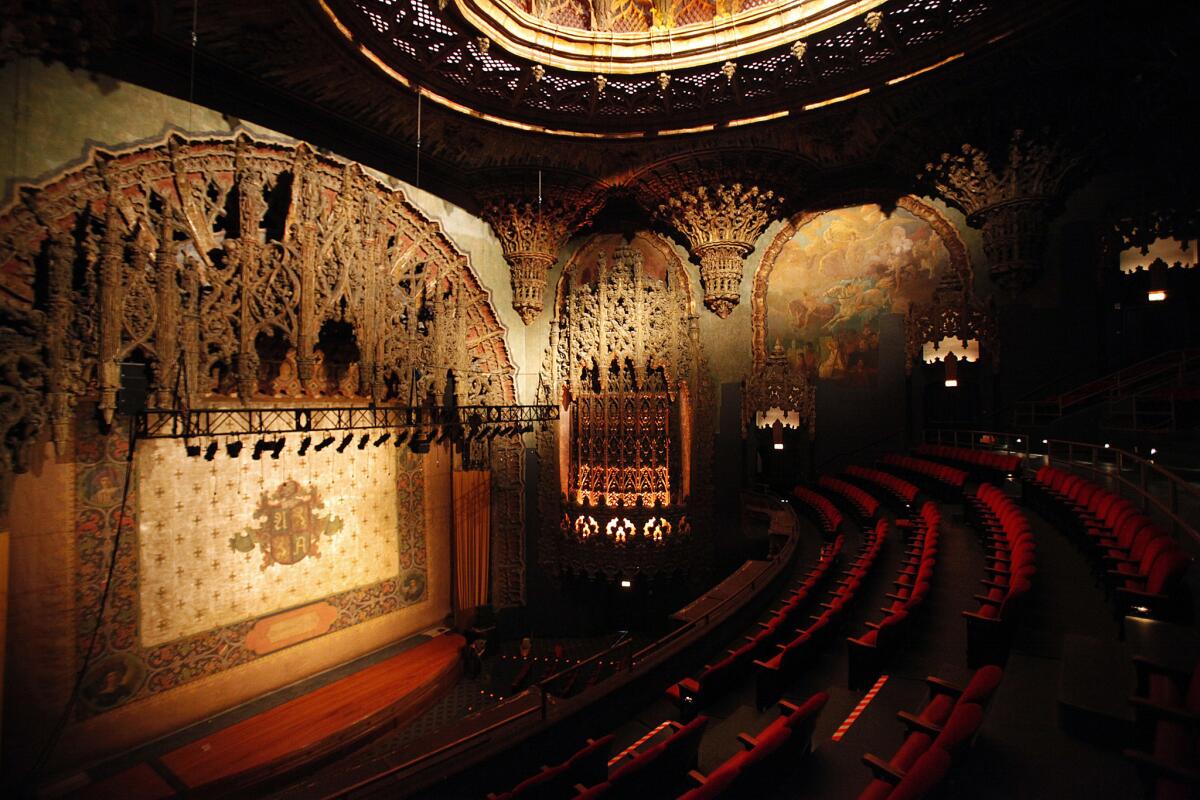Visiting an iPic Theater and considering moviegoing’s past, future

I treated myself to the latest and most extravagant in theatrical experiences a few days ago, but instead of making me excited about the arrival of the future, it made me melancholy about the loss of the past.
Not that my trip to the excellent new iPic Theater in Westwood wasn’t pleasurable, because it was. But I went not in search of gratification but because I’ve been doing a lot of thinking lately about the current nature and possible prospects of moviegoing. And I’m not alone.
Over just the last few months, I’ve collected a stack of stories dealing with how the theatrical experience might be changed to make customers happier and help keep those wonderful temples of entertainment open for business.
I even got an email from a friend in Ljubljana, Slovenia, telling me that the 90th anniversary of that city’s Kinodvor City Cinema is being marked with an international conference “on the role and meaning of the movie theater … debating the changing function and character of cinemas.” If they are thinking about that in Ljubljana, you better believe Los Angeles is concerned as well.
This is all happening now because the theatrical experience is under siege. Boxoffice magazine, the official publication of the National Assn. of Theatre Owners, reports that “approximately 200 million fewer tickets were sold in 2013 than in 2002, which remains the peak year for attendance in modern moviegoing.”
The reasons why are not hard to come by. Competition for leisure time is fierce, television is on a roll, video game sales numbers are through the roof, enough people are watching movies on small screens that the iPhone Film Festival (there’s an oxymoron for you) gets entrants from around the world, and new technology like Oculus Rift threatens to upend the entire experience.
Ideas as to what can be done to get people in the seats are also numerous. A company called Dealflicks encourages theaters to discount seats during off-peak hours, a new satellite network will make the showing of non-movie content like the Metropolitan Opera and the World Cup a lot easier, and enterprising theater chains are experimenting with added value offers like the Regal Super Ticket to the new “Transformers” movie, which for an added $15 offers the chance to own two digital HD copies of “Transformers” movies as well as a theatrical admission ticket.
More long-term fixes mentioned involve the core issue for theaters, improving the quality of the moviegoing experience. Digital projection, which eliminated worn-out, scratchy prints, was supposed to help, and it has.
Solutions include the possibility of Escape, a wraparound screen system that recalls Cinerama, and a new technology called 4DX, which according to a report by The Times’ Richard Verrier “combines moving and vibrating seats with wind, strobe, fog, rain and scent-based effects, all of which are synchronized to the action on-screen.” (As someone who ran out of the Loew’s Pitkin in Brooklyn, N.Y., when my seat vibrated during a childhood screening of William Castle’s schlock classic “The Tingler,” I can see the possibilities in that.)
Another way to improve moviegoing is to go upscale the iPic way, to charge steeper prices ($19 for regular seats, $29 for premium recliners) and to invest a lot of money and effort into making theatergoing less challenging and more pleasurable.
Certainly, the interior of Westwood’s iPic (there’s another one in Pasadena) does not resemble a classic theater. The old AVCO on Wilshire Boulevard has been gutted, and six new screening rooms have been placed in an elegant interior that looks more like an upscale hotel lobby than a movie house, with such déclassé items as movie posters relegated to the structure’s exterior wall.
The theater personnel are also all on their best behavior, dressed in black and unfailingly friendly and polite, even escorting us to our exceptionally comfortable seats facing a perfectly placed screen.
The food I ordered — our seat price made that an option — was tasty, the wine nicely chilled, but as someone who wants to focus on films even when I’m not on duty, I frankly found the presence of plates and glasses a distraction, and I winced when one of what iPic describes as its “ninja servers” inadvertently clattered dishes during one of “Maleficent’s” more emotional moments.
And though I enjoyed iPic’s careful cosseting enough to make me sure I’ll be going back, what my evening most made me think about was an experience I’d had a few months earlier that was simultaneously the same yet completely different.
As a visitor to the Cinequest film festival in San Jose, I had a chance to tour that city’s superb California Theatre. It’s a magnificent 1,100-plus seat old-school 1927 movie palace that took five years to restore at a cost of $75 million, with more than a third of the cost coming from philanthropist and legendary movie buff David Packard’s Packard Humanities Institute.
If the price point of an iPic ticket makes it somewhat of an elite experience, seeing it after the California (now used for opera and classical music as much as film) reminded me that back in the day, movie theaters with large staffs and elaborately uniformed ushers made everyone who walked in the door feel special. Yes, these theaters cost a bit more than the neighborhood variety, but being treated royally at the movies was very much a mainstream experience.
Walking through the California made me long for those long-gone days, which is why what makes me as happy as the iPic is that Los Angeles’ long-slumbering downtown movie palaces are finally coming back to life. I haven’t had a chance yet to visit Broadway’s fully rehabbed Theatre at Ace Hotel, formerly the United Artists, but I can’t wait to go and experience the combination of mass and class that made these movie palaces so special. I know the past isn’t coming back, but that doesn’t stop me from hoping that it will.
More to Read
Only good movies
Get the Indie Focus newsletter, Mark Olsen's weekly guide to the world of cinema.
You may occasionally receive promotional content from the Los Angeles Times.











